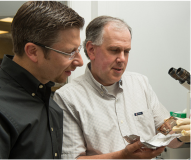| The Advanced Photon Source at Argonne National Laboratory is a unique high-energy x-ray source, which provides state-of-the-art hard x-ray tools available to scientists worldwide. Through x-ray microscopy and imaging, we can illuminate complex hierarchical structures from the molecular level to the macroscopic level, and study how they change in time and in response to stimuli. These non-destructive analytical techniques are ideally suited for the study of a wide area of materials ranging from paints, metal ware to ceramics in previously unavailable detail. Thus, x-ray microscopy provides valuable and unique opportunities for cultural heritage research. |
|
Our research on Picasso paints in collaboration with the Art Institute Chicago has been covered by news media worldwide, including The New York Times, Chicago Tribune, YAHOO! News, NewScientist, and many more. Our studies of 19th century daguerreotypes, which we are carrying out in collaboration with the Smithsonian Institution, have been featured, e.g., in the Chicago Tribune, Voice of America, and by Viewpoints. |
| Volker Rose (Argonne) and Francesca Casadio (Art Institute of Chicago) in the Hard X-ray Nanoprobe research station at APS Sector 26. The microscope allowed the scientists to learn that the chemical makeup of paint used by Picasso matched the chemical makeup of the first commercial house paint, Ripolin. |
| Volker Rose, a physicist in Argonne National Laboratory's X-ray Science Division, and Edward Vicenzi, a research scientist at the Smithsonian Institution's Museum Conservation Institute, review sulfur oxide-induced degrading around the edges of one of the museum's 160-year-old daguerreotype images, the world's first practical form of photography. The duo was able to collect the highest resolution data in the world for these types of images using the hard X-ray nanoprobe at the Advanced Photon Source and the Center for Nanoscale Materials located at Argonne Lab. |
| Argonne Highlights |
|
| Selected Publications |
|
| Collaborators |
|


